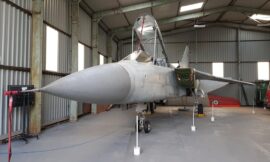The F-84F Thunderstreak stands as a testament to the evolution of jet-powered fighter aircraft during the early Cold War era, offering a glimpse into the technological advancements and operational capabilities of the United States Air Force (USAF) in the 1950s and 1960s. Developed as an improved version of the earlier F-84 Thunderjet, the Thunderstreak represented a significant leap forward in terms of performance, agility, and versatility.
The F-84F Thunderstreak was designed by the Republic Aviation Corporation to meet the USAF’s requirement for a swept-wing fighter-bomber capable of delivering nuclear weapons and conducting tactical strike missions. Introduced in the late 1940s, the Thunderstreak featured a sleek, streamlined fuselage, swept-back wings, and a powerful turbojet engine, allowing it to achieve high speeds and operate at altitudes previously unattainable by piston-engine aircraft.
One of the defining features of the F-84F was its swept-wing design, which improved aerodynamic efficiency and maneuverability compared to its predecessor. The aircraft also boasted a more advanced avionics suite, including radar navigation systems and target acquisition equipment, enhancing its ability to operate in all weather conditions and conduct precision strikes against ground targets.
The Thunderstreak’s armament consisted of a combination of guns, rockets, and bombs, making it a versatile platform for both air-to-air and air-to-ground missions. Its primary air-to-air weapon was the M3 Browning .50 caliber machine gun, supplemented by underwing hardpoints for mounting rockets and bombs. Additionally, the F-84F was capable of carrying and delivering nuclear bombs, further expanding its role as a strategic deterrent in the burgeoning Cold War.
In terms of performance, the F-84F was a significant improvement over its predecessor, with a top speed exceeding Mach 1 and a service ceiling of over 40,000 feet. Its powerful engine and streamlined airframe allowed it to accelerate quickly and maintain high speeds during both level flight and rapid climbs, giving it an edge in both air combat and ground attack missions.
The Thunderstreak saw extensive service with the USAF and various NATO air forces throughout the 1950s and 1960s, participating in numerous Cold War-era conflicts and crises. It played a crucial role in NATO’s defense strategy, serving as a frontline fighter-bomber and nuclear deterrent against potential Soviet aggression in Europe.
Despite its impressive performance and capabilities, the F-84F Thunderstreak was not without its drawbacks. It had a reputation for being difficult to fly, particularly at low speeds and during landing and takeoff maneuvers, earning it the nickname “Lead Sled” among pilots. Additionally, advancements in jet engine technology and the emergence of more modern aircraft designs eventually rendered the Thunderstreak obsolete, leading to its gradual retirement from frontline service in the late 1960s and early 1970s.
Today, the F-84F Thunderstreak is remembered as a symbol of the United States’ military prowess and technological innovation during the early Cold War period. Although it may have been overshadowed by more famous aircraft of its era, the Thunderstreak’s contributions to aviation history and its role in shaping the geopolitical landscape of the 20th century should not be underestimated.



